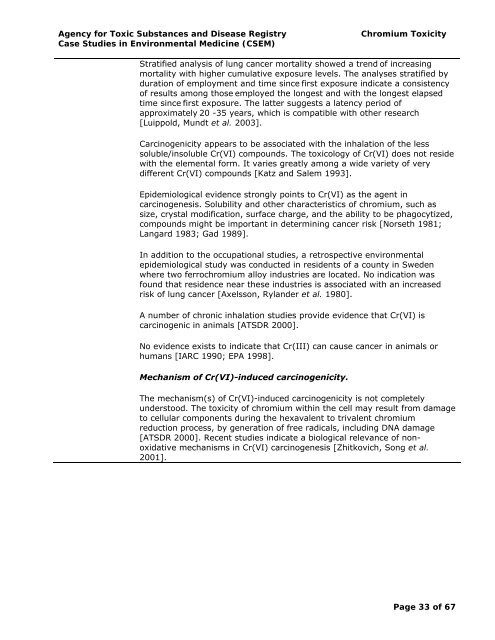(Cr) Toxicity | ATSDR - CSEM - Agency for Toxic Substances and ...
(Cr) Toxicity | ATSDR - CSEM - Agency for Toxic Substances and ...
(Cr) Toxicity | ATSDR - CSEM - Agency for Toxic Substances and ...
You also want an ePaper? Increase the reach of your titles
YUMPU automatically turns print PDFs into web optimized ePapers that Google loves.
<strong>Agency</strong> <strong>for</strong> <strong>Toxic</strong> <strong>Substances</strong> <strong>and</strong> Disease Registry Chromium <strong><strong>Toxic</strong>ity</strong><br />
Case Studies in Environmental Medicine (<strong>CSEM</strong>)<br />
Stratified analysis of lung cancer mortality showed a trend of increasing<br />
mortality with higher cumulative exposure levels. The analyses stratified by<br />
duration of employment <strong>and</strong> time since first exposure indicate a consistency<br />
of results among those employed the longest <strong>and</strong> with the longest elapsed<br />
time since first exposure. The latter suggests a latency period of<br />
approximately 20 -35 years, which is compatible with other research<br />
[Luippold, Mundt et al. 2003].<br />
Carcinogenicity appears to be associated with the inhalation of the less<br />
soluble/insoluble <strong>Cr</strong>(VI) compounds. The toxicology of <strong>Cr</strong>(VI) does not reside<br />
with the elemental <strong>for</strong>m. It varies greatly among a wide variety of very<br />
different <strong>Cr</strong>(VI) compounds [Katz <strong>and</strong> Salem 1993].<br />
Epidemiological evidence strongly points to <strong>Cr</strong>(VI) as the agent in<br />
carcinogenesis. Solubility <strong>and</strong> other characteristics of chromium, such as<br />
size, crystal modification, surface charge, <strong>and</strong> the ability to be phagocytized,<br />
compounds might be important in determining cancer risk [Norseth 1981;<br />
Langard 1983; Gad 1989].<br />
In addition to the occupational studies, a retrospective environmental<br />
epidemiological study was conducted in residents of a county in Sweden<br />
where two ferrochromium alloy industries are located. No indication was<br />
found that residence near these industries is associated with an increased<br />
risk of lung cancer [Axelsson, Ryl<strong>and</strong>er et al. 1980].<br />
A number of chronic inhalation studies provide evidence that <strong>Cr</strong>(VI) is<br />
carcinogenic in animals [<strong>ATSDR</strong> 2000].<br />
No evidence exists to indicate that <strong>Cr</strong>(III) can cause cancer in animals or<br />
humans [IARC 1990; EPA 1998].<br />
Mechanism of <strong>Cr</strong>(VI)-induced carcinogenicity.<br />
The mechanism(s) of <strong>Cr</strong>(VI)-induced carcinogenicity is not completely<br />
understood. The toxicity of chromium within the cell may result from damage<br />
to cellular components during the hexavalent to trivalent chromium<br />
reduction process, by generation of free radicals, including DNA damage<br />
[<strong>ATSDR</strong> 2000]. Recent studies indicate a biological relevance of nonoxidative<br />
mechanisms in <strong>Cr</strong>(VI) carcinogenesis [Zhitkovich, Song et al.<br />
2001].<br />
Page 33 of 67

















